
Sts. Cosmas and Damian the Anagyri
This rather stereotypical phrase is descriptive of a proud parent speaking of the accomplishment of their children. Even today, we express great joy when our sons or daughters reach that lofty position of becoming a physician. The place of doctors has always been one of respect and admiration. Throughout history, the dedication of healers has usually brought prestige, social status as well as financial reward. This is true today and it was true in antiquity. This brings us to a series of saint-brothers who shared their given names and were all physicians. The brothers commemorated November 1st. are the first in this remarkable grouping. We have become familiar with their stories. As Christians, they shared the conviction that the gifts which God had given them and which they had nurtured through study and hard work should be given back to those whom they served. Physicians who served and asked nothing in return, but why? First and foremost, these men were raised in an environment which allowed them to put their gifts and abilities realistically. Their upbringing allowed them to look at their talents as “on-loan” from God. Each of us are given gifts to nourish and develop; most do this wither it is by education or practice or both. What many of us forget, in the process, is the source of our gifts. These three pairs of brothers knew that God had given them their gifts, the development of these gifts was inspired by God’s Holy Spirit and most importantly, the use of them was directed by Christ and His message of Love.
The greatest gift all these doctors have shared with us is not the gift of healing, as profound as it is, nor the example of giving as admirable as we know it to be; but the lesson of perspective. They knew the source of all gifts and thanked God by developing them and offering them back to God through His people. What are your gifts? What are you doing with them? How do you look upon them: as your right or the gift of a generous God?
]]>
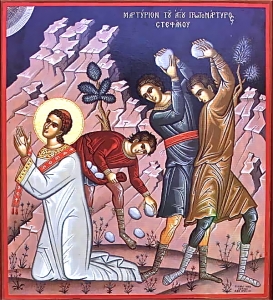
The Martyrdom of St. Stephen
It is the end of a year, the twilight of December and these few days in the Church’s calendar could be called the Days of the Innocents. Starting on December the twenty-seventh, our Holy Orthodox Church commemorates a series of feast days remembering the blood of martyrs shed for Christ. The first day, we commemorate the Protomartyr Stephen. The Deacon Stephen is remembered in the Church as the first Christian martyr, which is technically correct in that he was stoned to death after Pentecost (Acts 6 & 7). St. Stephen spoke to the people of Israel summarising the fulfilment of the promise of God in the person of Jesus, who had been crucified. Stephen was forthright and pronounced Jesus “the Righteous One of Israel”, identifying Him as the Messiah. The enraged the crowd attacked Stephen and stoned him. With his eloquence, St. Stephen used Jewish history to confirm Jesus as the Anointed One. It is declaration of faith and his sacrifice, which we commemorate some two thousand years later.
Lost in the celebration of Saint Stephen are two martyrs of the Iconoclastic Controversy. Sts. Theodore and Theophanes Graptoi, who first suffered branding on their faces with a poem ridiculing their support for icons. They knew that Christ had lived as truly God and truly Man here on earth. They endured because they affirmed Christ’s Incarnation by their support of the Holy Icons. Imprisoned with St. Methodios the Confessor, the brothers died because of the belief in Christ Born for humanity.
The calendar then calls to our attention, the “Twenty-Thousand Holy Martyrs of Nicomedia.” In 302 A.D. these devout Christians celebrating the Feast of the Nativity According to the Flesh of Our Lord, God and Saviour Jesus Christ were burned to death within their church. Can you imagine, twenty-thousand willing to die at one time for their faith. For us the number is mind boggling, yet we have experienced greater numbers of martyrs in the last decades; we have witnessed unknown Christian martyrs in the gulags and Communist prisons across Eastern Europe. Last week, we saw His All Holiness, Bartholomew 1 and his dwindling flock in Constantinople, revealed as living confessors for the faith. Nonetheless, twenty-thousand martyrs at one time still evokes wonder and awe in our hearts.
There is no more poignant feeling in the hearts of humanity than the thought of children suffering. Each of us have been touched by the vision of one child in pain or one child needlessly afflicted. Just a few days ago, we celebrated the birth of one Holy Child for whom the world had waited for generations. This little child born, in a cave, is born for the world’s salvation. With His coming, the world has discovered Light, but darkness is stubborn; and does not retreat willingly. The blood of fourteen-thousand innocent children in and around Bethlehem is testimony to this darkness. These babes, martyrs for Christ, were a glimpse into Christian history. The Church is watered by the blood of innocence. Only a short time from the joy of His Birth, we are faced with bitter weeping of so many deaths. This dichotomy has been repeated all to many times in history. The lives lost for the Saviour are beyond counting. In each age men, women and innocent children have followed His footsteps, taken up their cross and obeyed His commandment of love. “Greater love has no man than this, that a man lay down his life for his friends.” ( John 15, 13) Additionally, we celebrate the commemoration of all the Christians who have died of starvation, of thirst, of cold, by the sword and by every other kind of violent death. The memory of these Christians, who died from hunger, thirst, by sword and freezing is remembered even though, we don’t have record of their names; God knows these martyrs . Their synaxis is served in the temple of the Theotokos in Chalcopratiya (in Constantinople) where the holy ark with the sash of the Most Holy Theotokos was placed. As we see across the ages, millions of Christians have looked to the heavens and uttered the prayer of St. Stephen: “Lord Jesus, receive my Spirit.” (Acts 7, 59)
So as we begin a new year, we do so with the examples of the martyrs to give us courage so that we can face the unknown. Yet, this unknown will not have darkness, because the Light of the world has been born in a cave and banished darkness for all time! Christ is Born! Glorify Him!!
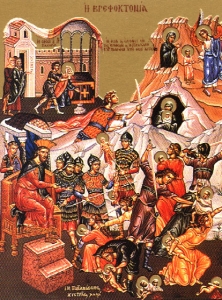
The Slaughter of the Innocents
]]>
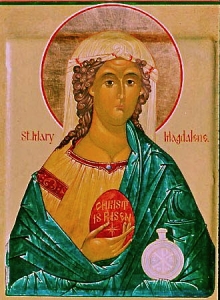
St. Mary Magdalene
July 22 is the Feast Day of St. Mary Magdalene. I believe that Mary is one of the most interesting of our saints. She is a woman of great theological significance, but she is not well documented in history. The Tradition of the Church, gives us a good bit to think of concerning this special person. She carries several “titles” in the Church usage. She is known most of all as Mary Magdalene. With this, we know she came from a town named Magdala. This city was located on Lake Gennesaret (“a garden of riches”), which is another name for the Sea of Galilee or Lake Tiberias. Geographically the town would be located presently north-west of Haifa, Israel near the Golan Heights. This places her town north of Nazareth. Mary also carries the titles of “Apostle to the Apostles, Equal to the Apostles and of course Myrrh-bearer” There is mistaken idea that Mary was a prostitute before she met Jesus. This is not true! There is a tradition that Mary Magdalene led such a chaste life that the devil thought she might be the one who was to bear Christ into the world, and for that reason he sent seven demons to torment her. The first time Mary is mentioned in the Gospels is St. Luke 8,1-3; Christ freed her from these demons and she followed him thereafter. She is considered one of the Galilean disciples. We see her prominently in the Passion narratives. She followed Jesus to Jerusalem and was steadfast at the foot of the Cross with The Virgin Mary standing by Jesus in His darkest moments. She figured importantly in the post-resurrectional accounts. She is the first person to see the Risen Lord, whom she saw twice, she spoke to Him near the tomb, She was the first to announce the Resurrection. The privilege of being the “first” witness of the resurrection that was granted to Mary by the Lord is something that twentieth century sensibilities need to absorb. In the time of Christ, women were not considered creditable witnesses. They were not allowed to give testimony, only men were considered believable. Yet to Jesus this didn’t matter. He trusted these disciples, these women disciples to deliver the greatest news in the history of the world. She had seen Jesus die on the Cross, seen Him buried, seen the great stone set at the door, seen the guard posted at the door of the tomb, her tears were shed for her teacher, she saw a stranger in the Garden, until she heard a familiar voice call her name. She then saw Him resurrected and glorified. Joy overcame sorrow! As Jesus instructed her, Mary Magdalene found the other disciples. She was a member of the inner circle; she was trusted by them and when she delivered the message, “I have seen the Lord” (John 20,18) they did not believed her. Jesus had to appear to them and upbraid them before, even her friends, would believe such news. The other appearances of Jesus are well documented in the Gospels.
After the Ascension and Pentecost, Mary travelled from Jerusalem to Rome where she announced the resurrection. One tradition concerning Mary Magdalene says that she used her position to gain an invitation to a banquet given by Emperor Tiberius. When she met him, she held a plain egg in her hand and exclaimed “Christ is risen!” Caesar laughed, and said that Christ rising from the dead was as likely as the egg in her hand turning red while she held it. Before he finished speaking, the egg in her hand turned a bright red (for more details, see Wikipedia). Each time we answer, “Truly, He is Risen!” we should think of Mary. After many years evangelising across the Mediterranean area, she travelled to Ephesus where she joined St. John the Evangelist and her friend, the Virgin Mary, the Theotokos. There she died peacefully. During the second Patriarchate of St. Photios the Great, he had her relics transferred to the Queen City (Constantinople).
]]>
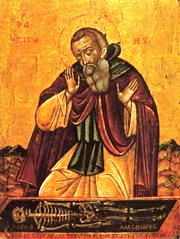
Abba Sisoes the Great
On July 6th, the Holy Church commemorates Abba Sisoes the Great. We are so far removed from the desert fathers and mothers, the abbas and ammas, perhaps we should speak a little about these desert dwellers and their lives. Why did they flee from society and what was the call of these wilderness places? Names like Anthony, Arsenios, Pambo, Syncletica, and Macarios evoke a life of self denial and hardship. Places like Nitria, Rhaithou, Scetis and Eleutheropoulos as well as other isolated locales sound strange and distant. Nonetheless, they are part of our Orthodox identity and Tradition. These men and women sought to “follow Christ” and renounced a life in the world. They had as their model St. John the Forerunner and took to heart the call to Repent, for the Kingdom of Heaven is at hand! They sought to be like angels, to confront evil face to face and to constantly praise and glorify God. Most were lay persons and many were uneducated simple peasants. They saw themselves as sinners, tried to know themselves and to treat all with love and humility. Many came to listen to their counsel even though they sought solitude. Their short sayings have come down to us as beacons of spiritual light. These short sayings are available in books like The Philokalia, The Apophthegmata Patrum, The Sayings of the Desert Fathers and other works. Modern scholars like Fr. John Chryssavgis, Benedicta Ward and Dermas Chitty and many more have made their words accessible. Today, we can sit at their feet for a few minutes as did the pilgrims who travelled to deserted places. We too can benefit from their wisdom. In our age of cult celebrity and “me first” attitudes; don’t the words of spiritual guides such as Sisoes the Great echo in our hearts. In the early fifth century on Anthony’s Mountain, a monk asked Sisoes: “How can I attain humility?” The saint replied: “When a person learns to see themselves as inferior to all creatures, with that he attains humility.” (Ward, Benedicta, ed. 1984. The Sayings of the Desert Fathers: The Alphabetical Collection. Revised ed. Kalamazoo MI: Cistercian Publications, p. 214.) The Venerable Sisoes the Great fell asleep in the Lord in 429 AD.
Apolytikion of the Venerable Sisoes the Great
“You proved to be a citizen of the desert, an angel in the flesh, and a wonder-worker, O Sisoes, our God-bearing Father. By fasting, vigil, and prayer obtained heavenly gifts, and you healed the sick and the souls of them that have recourse to thee with faith. Glory to Him that has given you strength. Glory to him that has crowned you. Glory to Him that works healings for all through you.”
Holy Abba Sisoes: Pray for us sinners.
]]>






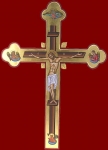 The True Cross
The True Cross